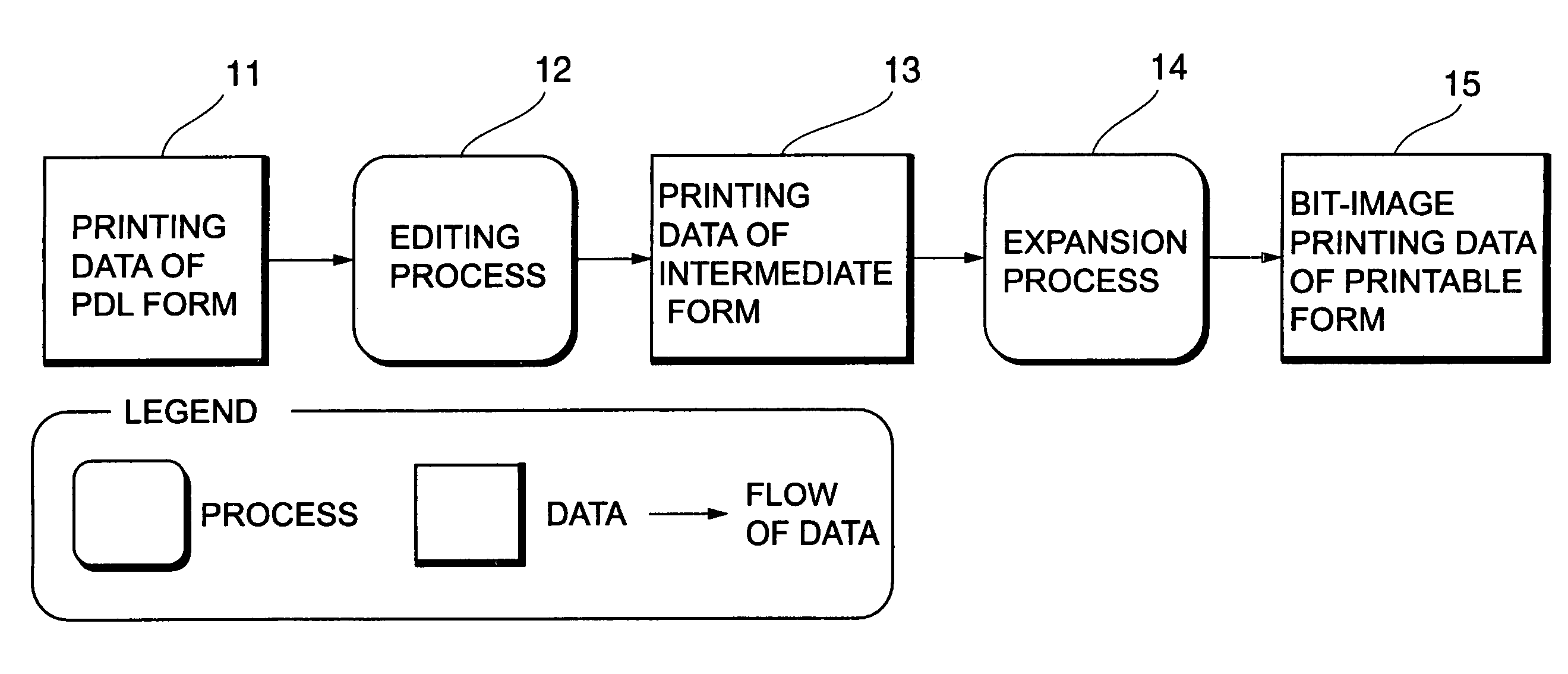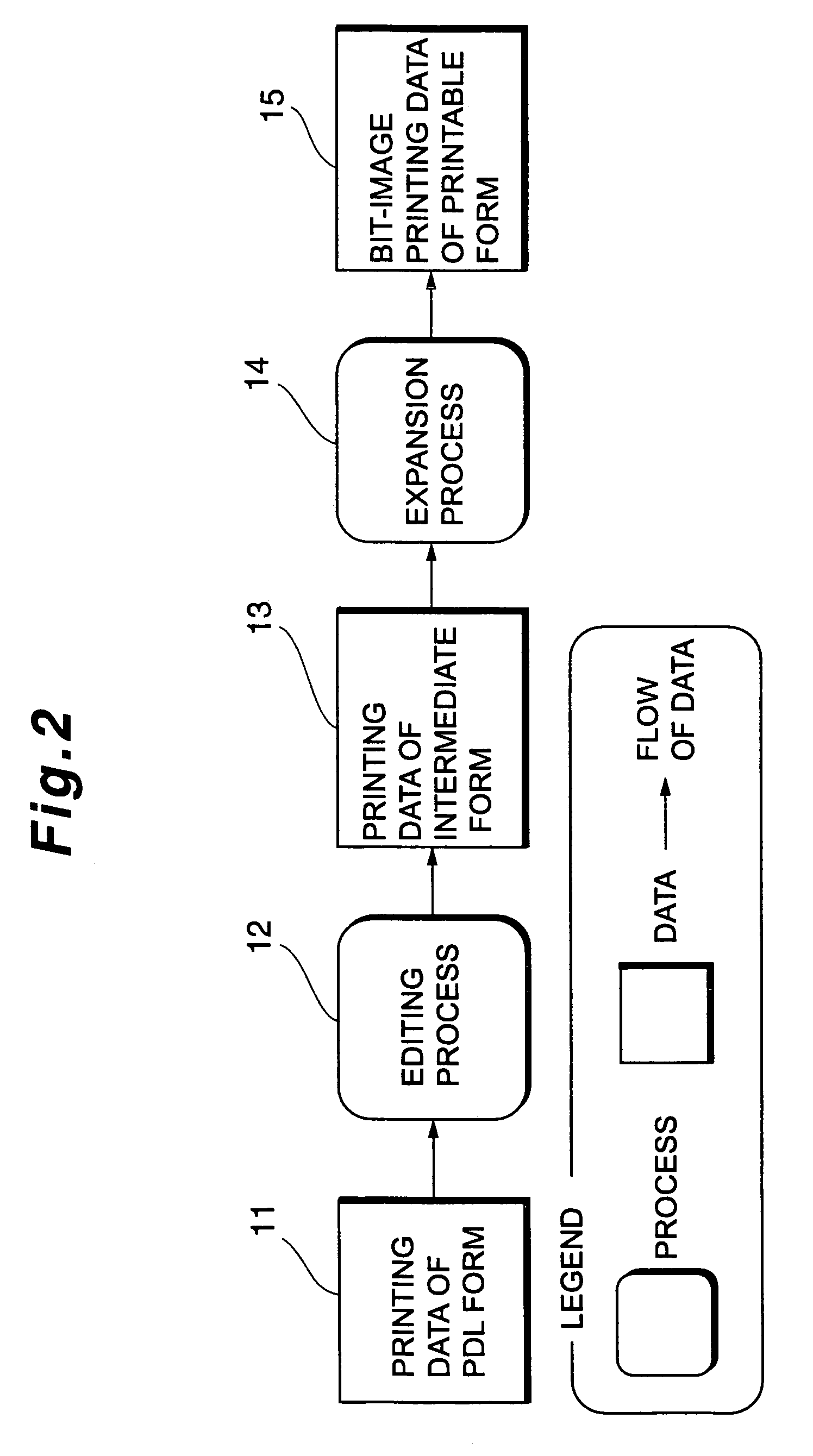Printing data processor which manages memory
- Summary
- Abstract
- Description
- Claims
- Application Information
AI Technical Summary
Benefits of technology
Problems solved by technology
Method used
Image
Examples
first embodiment
[0045]FIG. 1 is a block diagram of a printing data processor 10 according to a first embodiment of the present invention.
[0046]Prior to description referring to FIG. 1, brief description will be made of the flow of printing data to be processed by the printing data processor.
[0047]FIG. 2 is an explanation diagram of the flow of printing data.
[0048]As shown in FIG. 2, a printing data processor 10 according to the present invention receives printing data 11 of PDL form from a host A (See FIG. 1). Printing data 11 of PDL form is edited by an editing process part 12 and temporarily becomes printing data 13 of intermediate form called a display list, which is not dependent on the kind of PDL. Printing data 13 of intermediate form is expanded by an expansion process 14 to printing data of printable bit image form.
[0049]As has been described, the amount of memory used for the editing process greatly differs with the mode of reproduction, in other words, with the page printing mode. An exam...
second embodiment
[0090]A printing data processor according to a second embodiment comprises an editing process part 1 (FIG. 1) and an intermediate-form printing data memory 6 (FIG. 1), which are the same as those described with reference to the first embodiment. The printing data processor further comprises a plurality of expansion process parts.
[0091]The printing data processor according to the second embodiment selects one expansion process part suitable for a reproduction mode of printing data on the basis of page state data from the plurality of expansion process parts. Printing data of PDL form is expanded by the selected expansion process part to printing data of printable form. This printing data processor is described in detail as follow.
[0092]FIG. 7 is a block diagram of the printing data processor 10 to show the second embodiment.
[0093]The printing data processor 10 in FIG. 7 is installed in the printer controller of a printer and illustrated by using separate function blocks. In this exam...
third embodiment
[0115]The object of the printing data processor according to a third embodiment is to add a system management part to the printing data processor according to the second embodiment to enable efficient printing on both sides of paper.
[0116]At first, the function of printing on both sides is described with reference to drawings. Both-side printing normally means to print on the front and back sides of a sheet of paper. In this case, a path is required to turn over paper one side of which has been printed (hereafter referred to as a paper inverting path). An example of a method is shown below which is ordinarily employed in a printer with a mechanism wherein there is one sheet of paper on the paper inverting path.
[0117]FIG. 9 is a diagram for explaining printing on both sides of paper.
[0118]The printing sequence starts with the second page and proceeds to the fourth page, the first page, and the sixth page, the third page and so on.
[0119]The important point requiring attention is as fo...
PUM
 Login to View More
Login to View More Abstract
Description
Claims
Application Information
 Login to View More
Login to View More - R&D
- Intellectual Property
- Life Sciences
- Materials
- Tech Scout
- Unparalleled Data Quality
- Higher Quality Content
- 60% Fewer Hallucinations
Browse by: Latest US Patents, China's latest patents, Technical Efficacy Thesaurus, Application Domain, Technology Topic, Popular Technical Reports.
© 2025 PatSnap. All rights reserved.Legal|Privacy policy|Modern Slavery Act Transparency Statement|Sitemap|About US| Contact US: help@patsnap.com



